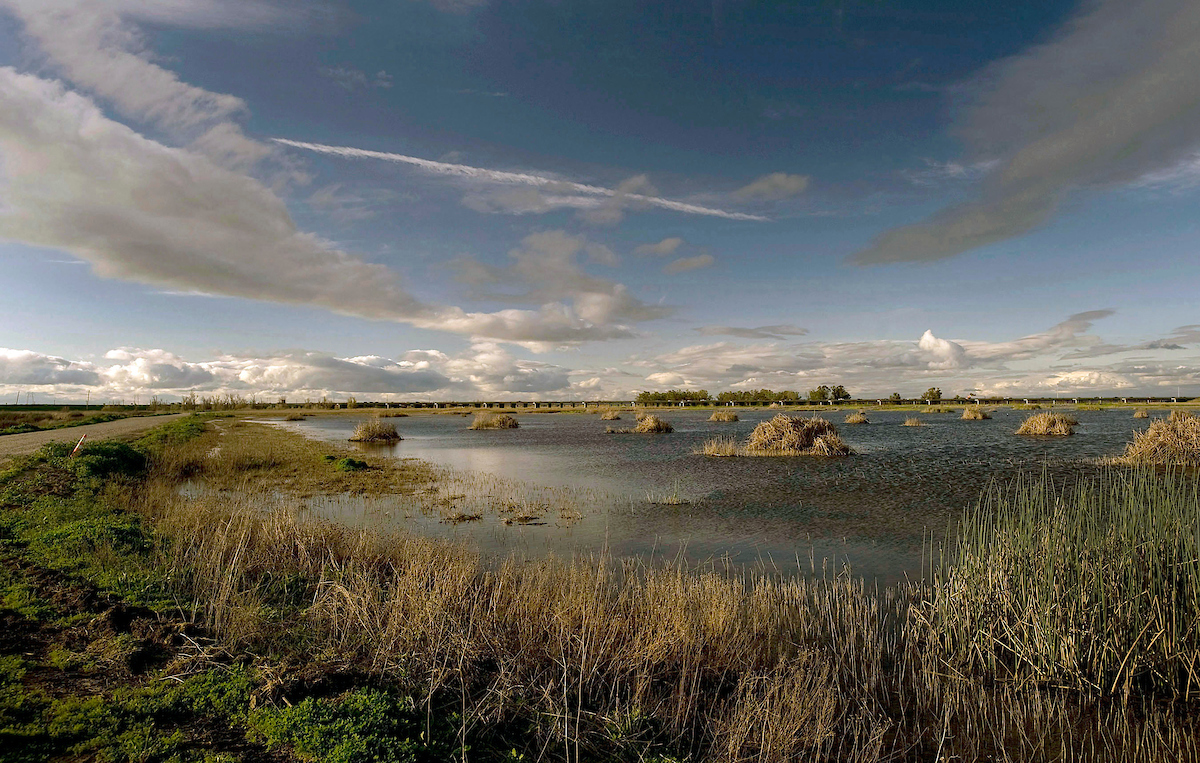
This article was originally featured on EDF’s Growing Returns blog. By Anna Schiller (Bio)
I wasn’t expecting to see egrets, herons and pelicans on my first trip to the San Joaquin Valley — a region in the southern part of California’s Central Valley known for its impressive agricultural production and scorching summer heat. I didn’t find these birds at one of the valley’s few wildlife refuges, but at a groundwater recharge facility designed to spread and infiltrate surface water into the ground below.
Recharge basins are becoming increasingly popular in overdrafted regions in California, where water managers are seeking solutions to balance groundwater supply and demand to comply with the state’s Sustainable Groundwater Management Act (SGMA).
The multiple benefits of recharge basins
Water managers and farmers can use recharge basins — essentially man-made ponds or lakes — to capture excess runoff from increasingly intense winter storms. They can then store the water in the basin for future use or let it permeate into the ground to bolster groundwater levels and avoid issues such as land subsidence and domestic well failure.
While some recharge basins are dug deep and kept “clean” of plants, others like the one I visited mimic historic habitat, with features like shallow sloping basin floors and plant-covered islands.

Proven success in delivering co-benefits

Groundwater recharge basins offer the opportunity to create more habitat for birds like these black-necked stilt frequently found in the Central Valley.
Sustainable Conservation has been working with California irrigation districts for the past five years to identify locations for recharge projects and make the most of available surface water supplies. Though the districts they work with are primarily focused on recharge efficiency and cost savings, Dr. Daniel Mountjoy, Director of Resource Stewardship, noticed some managers incorporating multi-benefit features.
“These managers found that planting basin floors was enhancing infiltration rates and that sloped basins and banks were less likely to plug up with fine sediments,” he explained. “These measures were taken to improve recharge efficiency, but they were also incidentally creating excellent waterbird habitat.”
New guide will help water managers and growers build recharge basins that provide operational benefits while also creating valuable waterbird habitat.
And it takes only modest adjustments to recharge basin design and management for these bodies of water to also serve as a much-needed network of habitat for migratory waterbirds. We’ve already seen this successful coupling of recharge and habitat in the Sacramento Valley, where The Nature Conservancy’s BirdReturns program has used an Airbnb model to create thousands of acres high quality habitat on flooded rice plains.
Surging interest provides new opportunities

Watercolor of a flourishing recharge basin — a featured illustration in the guide.
With pressure to balance groundwater supply and demand mounting, there’s a surge in new plans for recharge basins and expansion of existing basins.
San Joaquin Valley water managers are already planning to build 15,000 acres of recharge basins in addition to the more than 30,000 acres already in place, according to a Point Blue study. Many anticipate even greater expansion in the coming years.
It’s important to note that, in California, the capacity of underground water storage — which these recharge basins enable — is estimated to be more than 20 times greater than the amount of currently available above-ground storage in reservoirs and lakes.
Some state and federal funding is available to support multi-benefit recharge projects, but additional incentives and regulatory assurances are needed to kick-start adoption at a greater scale and create much-needed habitat in California.
California’s Central Valley has lost more than 90% of its wetlands in the last century. We know it’s impossible to re-create all of those wetlands, especially given the region’s crucial role growing healthy food for the world. But as SGMA sparks greater interest in building recharge basins, farmers and water managers have an opportunity to develop valuable bird habitat while continuing to produce food.
I hope this guide will provide helpful information and encourage water managers and landowners to seize this opportunity.
